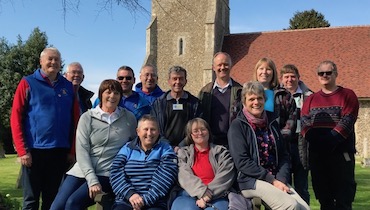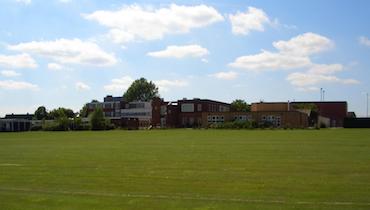M2F: 11 April 2019 - Coggeshall
Unusually our ART course was being run as part of the Essex Ringing Course so we started at Honeywell School with a theory lesson. Gill Hughes reminded us of the core ART disciplines of building up instruction in small steps and the importance of clear explanations and effective feedback. For those who had completed Module 1, this part was a reminder of the ART core strategy; how important it is to continue to employ these principles. All of our group had experience of teaching in their own towers and in local groups.
For the day’s practical sessions we moved on to Felsted where we rang on their simulator. The exercises here were designed to bring our learner from bell handling to ringing successfully with their band. We talked of basics like being able to move their hands up and down on the tail end to ring quicker and slower, to recognise their bell in the ringing by possibly using nursery rhymes or familiar sentences to pick out their own bell. We also did a clapping and sniffing (yes!) scheme to develop the correct pace for leading. Other exercises were whole pull and stand, standing all the bells apart from the tenor then coming back into rounds again, and more. These are all ‘new’ ideas, different to the traditional path to plain hunt, but designed to keep a band interested and motivated while gaining important key skills.
Kaleidoscope ringing came after lunch, with information about using this type of work to bring your learners on to ringing slower and faster at different strokes and elementary stroke counting so they know to move their bell without being specifically directed. All these exercises are designed to take a learner in small accurate steps towards call changes – rather than making the huge jump (for a learner) from rounds.
One clever idea is ‘Big change, Little change’ (changing 12,34 and 56, then 23, 45) and it was interesting to see how these changes, when run together, build the skill of three blow plain hunt. A major development which the learner is unlikely even to realise they have accomplished! Two other exercises, new to me, were Swicheroo and Crash and Gap. I was very glad we were on a simulator!
Finally we worked on ringing Bastow Minimus and Bastow Doubles so a learner on the treble could start developing rope sight.
All the exercises were fun and skills based, and intriguing to many of us who had been ringing on the traditional path for many years. Each exercise had a specific reason for being employed. There is certainly no excuse for practices not being varied and lively once you’ve done this course.
A final session back at Honeywell School covered coaching and building a band, advocating working with other teachers to benefit from shared assessments of your learners and how to develop an individual learner’s confidence.
Doing the M2F as part of the Essex Course did mean we had to split our day between Honeywell School, the Essex Course base location, and the tower where we were running the practical sessions, but what followed on days two and three made all this worthwhile. We were able to immediately put what we had been taught into practice with another Essex Course group who were working on their foundation skills. We were paired up to run part of the sessions under the watchful eyes of Ruth Suggett and David Sparling. Feeling rather thrown in at the deep end, and with only a little guidance from Ruth, we had to place our bands of experienced ringers and learners and both stand behind and direct the ringing. We could immediately realise the benefits of the ART exercises and understand how we needed to assess the students to make sure we gave them suitable ringing and didn’t overwhelm them by asking them to do exercises that were beyond them. The lively nature of the ringing and the co-operation and mutual interest was evident. Despite having so many ideas to try out, David and Ruth encouraged us to spend time in one-to-one sessions with a learner, looking closely at their handling and bell control. By the end of the second day, we were delighted to see ‘our learners’ able to achieve an acceptable Mexican Wave. Well done all!
Thanks to everyone who put in time organising our M2F course and the subsequent Foundation Skills group days, and to the excellent tutoring from ART personnel. Although three days on the trot is quite demanding, and we covered an enormous number of ideas, I am sure that everyone on the course now feels far more inspired and enthused about running practices.
Beth Johnson

Course Tutors: Gillian Hughes & David Sparling


Teaching from Rounds to Plain Hunt
Learn how to teach build really good foundation ringing skills in your ringers.